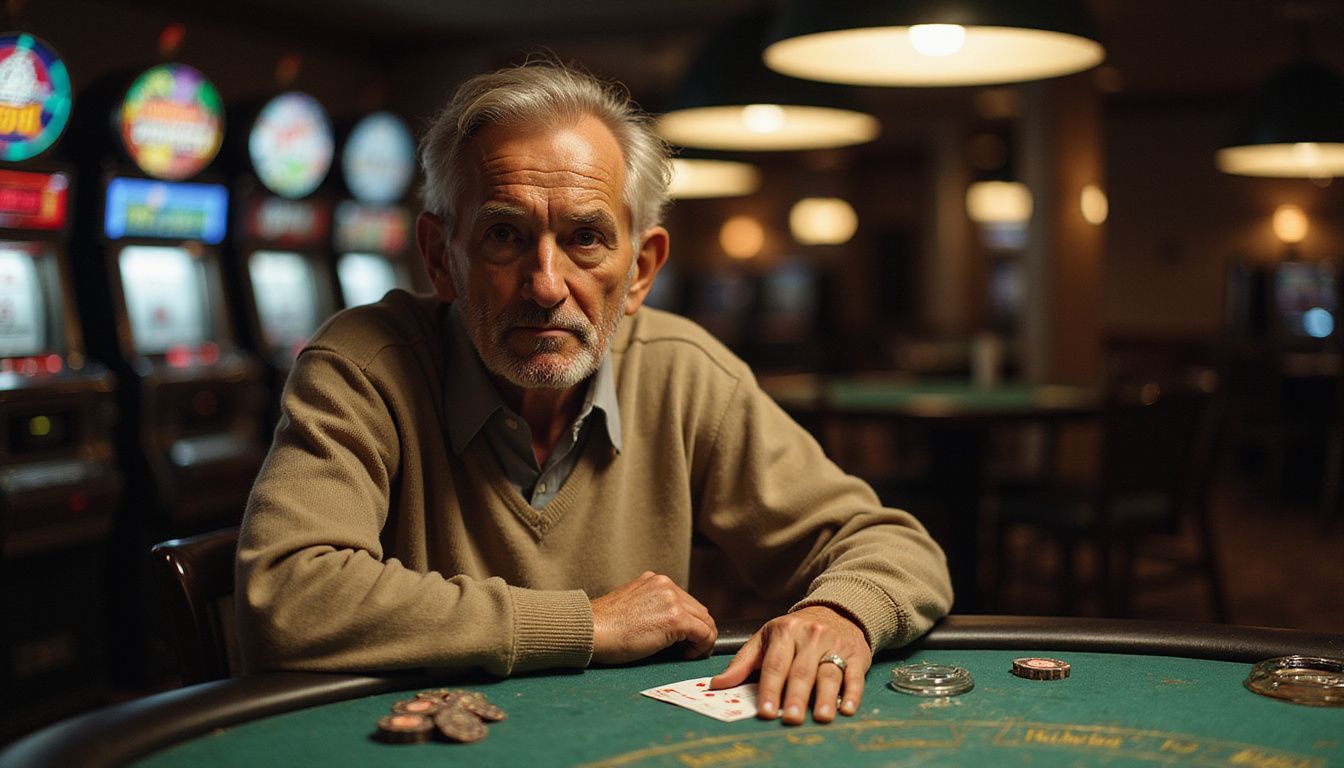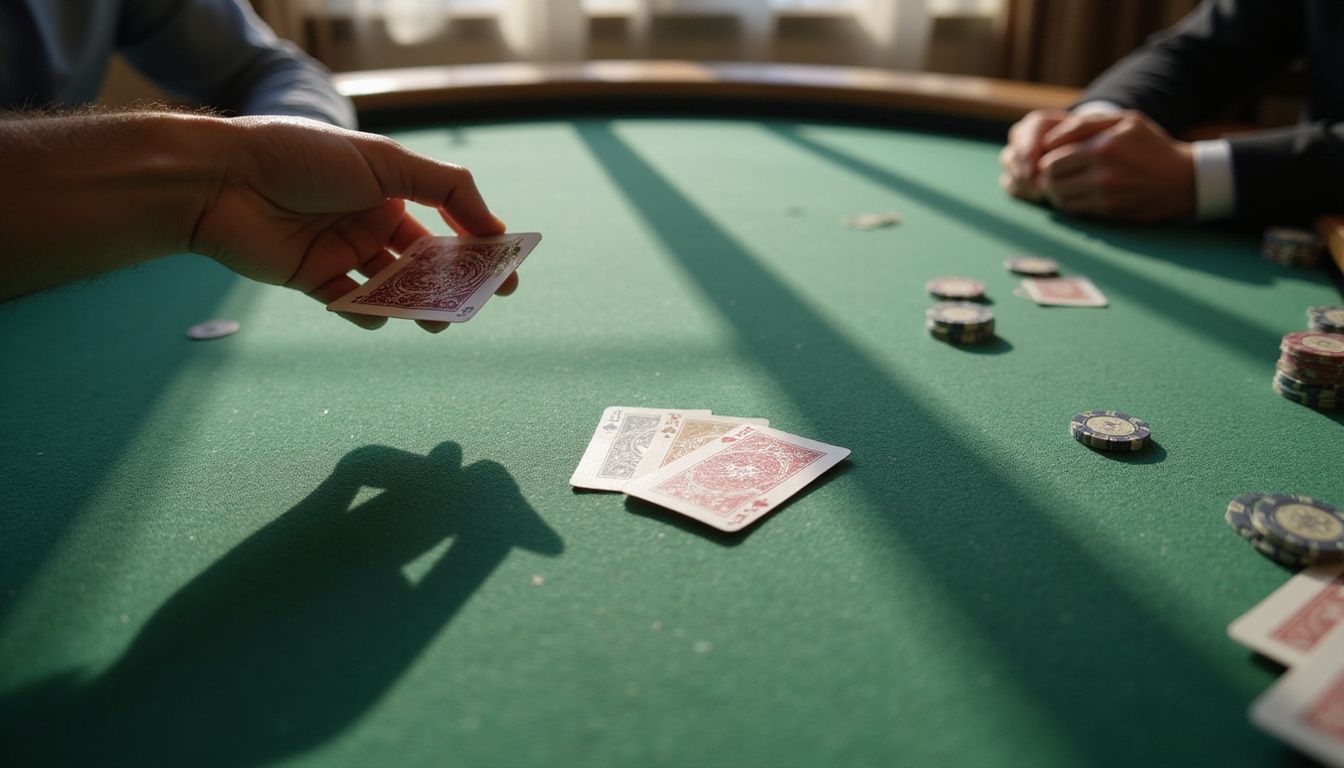Many blackjack players lose money because they don’t know when to walk away from bad hands. Surrender strategy blackjack allows you to give up half your bet instead of playing a likely losing hand.
This guide will show you exactly when to surrender based on your cards and the dealer’s up card. Master this move and watch your bankroll last longer at the tables.
What Is Surrender in Blackjack?

Surrender is a strategic option in blackjack that allows players to forfeit half their bet and end their hand immediately. This move serves as a damage control tactic when players face tough situations against the dealer.
Players use this option when math shows they’ll lose more than half their bet if they continue playing the hand. The surrender move works differently depending on casino rules, with some offering it after the dealer checks for blackjack (late surrender) and others before the check (early surrender).
Basic strategy charts show exactly when surrendering makes mathematical sense. These charts guide players on which hands to surrender based on their cards and the dealer’s up card.
For example, players should often surrender a hard 16 against a dealer’s 10 or Ace. The house edge drops when players use surrender correctly, making this move valuable for both beginners and experienced card counters who want to minimize losses at the blackjack table.
Types of Surrender
Blackjack surrender options vary across casinos and game formats. Players need to understand the key differences between early and late surrender to make smart decisions at the table.
Early Surrender
Early surrender gives players a powerful advantage at the blackjack table. This option allows you to forfeit half your bet before the dealer checks for blackjack. I’ve found this rule particularly valuable when facing a dealer’s ace or ten-value card.
The math supports this strategy—early surrender can reduce the house edge by about 0.24%, which adds up over time. Most casinos rarely offer this option because it favors players too much.
Early surrender is the holy grail of blackjack options—rare but worth seeking out.
Unlike late surrender, early surrender lets you escape bad situations even if the dealer has a natural blackjack. This makes a big difference with hands like hard 16 against a dealer’s ten or hard 15 against an ace.
The basic strategy charts for early surrender differ from standard charts. Players must adjust their decisions based on the specific rules at their table. Card counters especially prize games with early surrender since it provides extra protection against negative counts.
Late Surrender
Late surrender allows players to give up half their bet after the dealer checks for blackjack. This option only becomes available after the dealer peeks at their hole card to confirm they don’t have a natural 21.
Many casinos offer this form of surrender rather than early surrender because it maintains a higher house edge. Players signal a late surrender by drawing an imaginary line behind their betting spot on the blackjack table.
The dealer will then collect half your bet and remove your cards from play. Late surrender works best with hard 15 against a dealer’s 10 or with hard 16 against a dealer’s 9, 10, or ace.
Using basic strategy charts can help you decide exactly when to use this move at the blackjack tables.
Understanding when to use late surrender depends on several factors including the number of decks in play and specific house rules like whether the dealer hits or stands on soft 17.
For example, in multi-deck games where the dealer hits on soft 17, surrendering a hard 16 against a dealer’s ace can save you money in the long run. This strategic move cuts the house advantage by giving up half your bet instead of potentially losing all of it.
Now let’s explore when to use the surrender strategy in specific situations.
When to Use the Surrender Strategy
Knowing when to surrender can save you money in specific blackjack situations. The surrender option shines most when your hand has poor winning odds against the dealer’s strong up card.
Hard 15 vs. Dealer 10
Hard 15 against a dealer’s 10 presents one of the clearest surrender situations in blackjack. Players face a tough choice with this hand combination. Basic strategy charts show that surrendering a hard 15 against a dealer’s 10 up card saves money in the long run.
The math proves this point—you’ll lose more than 75% of these hands if you hit or stand. I’ve watched countless players stubbornly play through these hands at the blackjack table, only to lose their entire bet.
The difference between an amateur and a professional is knowing when to walk away from a hard 15 versus a dealer’s 10.
Your surrender decision changes based on the number of decks in play. Single-deck games might call for hitting instead of surrendering this hand. The dealer’s hole card remains unknown, but the 10 up card creates a strong dealer position.
Late surrender rules apply in most casinos, meaning you can only surrender after the dealer checks for blackjack. Color-coded strategy charts help players make this decision quickly at the table without costly mistakes.
Hard 16 vs. Dealer 9, 10, or Ace
Moving from the tough Hard 15 vs. Dealer 10 situation, players face an even trickier decision with Hard 16 against strong dealer cards. Basic strategy charts clearly show that surrendering a hard 16 against a dealer’s 9, 10, or Ace is often the smartest play.
This move cuts your losses by 50% in spots where the math shows you’ll lose more than half the time. Many blackjack pros use this surrender option to protect their bankroll during these tough hands.
The dealer’s up card greatly impacts your surrender choice. A hard 16 faces about a 77% chance of busting if you hit, making surrender valuable against strong dealer cards. Color-coded strategy charts mark these situations in red as clear surrender spots.
The number of decks also matters – single deck games might call for different choices than six-deck shoes. I’ve saved countless chips at the blackjack table by properly surrendering my 16s against these powerful dealer cards instead of stubbornly hitting or standing.
Total Dependent vs. Composition Dependent Strategy
Blackjack players can improve their surrender decisions by understanding two main strategic approaches. These methods differ in how they evaluate hand values and can affect your long-term results.
| Strategy Type | Definition | Application | Advantage |
|---|---|---|---|
| Total Dependent Strategy | Considers only the total value of your hand | Focuses on hard totals like 15 or 16 against dealer’s up-card | Simple to learn; works well with basic strategy charts |
| Composition Dependent Strategy | Analyzes the specific cards that make up your hand | Distinguishes between different card combinations that equal the same total | More precise; can reduce house edge by up to 0.01% |
| Example: A hard 16 made of 10-6 plays differently than a 9-7 or 5-5-6 against a dealer’s 10 | |||
| Game Impact: Single deck games benefit more from composition strategy than multi-deck games | |||
Most basic strategy charts use total dependent rules because they’re easier to memorize. Advanced players often switch to composition dependent strategies for an extra edge. The number of decks in play affects which approach works best. Color-coded surrender charts help visualize these decisions across different hand combinations.
Surrender Strategy for Single Deck Games
Single deck blackjack games offer players better odds compared to multi-deck versions. In these games, the surrender strategy differs slightly due to the reduced house edge. Players should surrender hard 15 against a dealer’s 10 and hard 16 against a dealer’s 9, 10, or ace in single deck games.
The basic strategy chart for single deck games shows fewer surrender situations because the player has a better chance with fewer cards in play.
I’ve played hundreds of single deck games in Las Vegas casinos and noticed that surrender options aren’t always advertised. You must ask the dealer directly if surrender is available before sitting down.
Color-coded strategy charts can help you make quick decisions at the table based on your hand values. The number of decks impacts your optimal surrender choices, making multi-deck games require a different approach to surrender decisions.
Surrender Strategy for Multi-Deck Games
Multi-deck blackjack games require specific surrender tactics due to the altered odds. Players should surrender hard 15 against a dealer’s 10 and hard 16 against a dealer’s 9, 10, or ace in these games.
The house edge increases with more decks, making surrender decisions more critical to your bottom line. Basic strategy charts for multi-deck games often show different surrender points than single-deck versions.
Card counting becomes more challenging in multi-deck games, but surrender strategy remains valuable. Players must adapt their approach based on the exact number of decks in play and whether the dealer hits or stands on soft 17.
Many online casinos offer multi-deck games with late surrender options, giving players a chance to cut losses in unfavorable situations. Next, we’ll examine how surrender works in online blackjack platforms.
Surrender in Online Blackjack
Online blackjack platforms often include the surrender option, though you need to check each site’s specific rules. Many virtual casinos offer late surrender, which lets players give up half their bet after the dealer checks for blackjack.
This feature can reduce the house edge by about 0.08% in multi-deck games. Players should look for the surrender button on their screen, usually located near other action buttons like “Hit” or “Stand.” Some online platforms also provide color-coded strategy charts that show exactly when to surrender based on your hand value and the dealer’s up card.
Basic strategy charts remain essential tools for online blackjack players considering the surrender option. The number of decks used in virtual games directly impacts your optimal surrender decisions.
For example, with a hard 15 against a dealer’s 10, surrendering is often the right move in an 8-deck online game but might not be in a single-deck version. Next, we’ll explore common mistakes players make when using the surrender strategy and how to avoid them.
Common Mistakes to Avoid When Surrendering
While online blackjack offers surrender options, many players make costly errors when using this strategy at the table. Players often misuse surrender due to lack of knowledge about proper timing and conditions, which increases the house edge against them.
- Failing to check if surrender is available before sitting down at a blackjack table. Many casinos don’t advertise this option, so you must ask the dealer directly.
- Surrendering too often against dealer up cards that don’t justify giving up half your bet. This mistake happens most with hands like hard 15 against a dealer 9.
- Not using surrender when basic strategy calls for it, especially with hard 16 against a dealer 10 or Ace. This error costs players money in the long run.
- Ignoring the difference between early surrender and late surrender rules. Early surrender offers better odds since you can fold before the dealer checks for blackjack.
- Misunderstanding the hand signal for surrender, which varies between casinos. Some require you to draw a line behind your bet, while others need a verbal declaration.
- Applying single-deck surrender strategy to multi-deck games. The optimal surrender decisions change based on how many decks are in play.
- Forgetting that dealer hitting or standing on soft 17 affects your surrender decisions. This rule variation changes the math behind when to give up your hand.
- Making surrender decisions based on gut feelings rather than mathematically proven strategy charts. Emotions lead to costly mistakes at the blackjack table.
- Failing to adjust surrender strategy based on card composition. A hard 16 made of 10-6 plays differently than 7-9 in some situations.
- Trying to surrender after taking additional actions like hitting or doubling. Once you take another action, the surrender option disappears.
Advanced Tips for Mastering the Surrender Strategy
Expert blackjack players know that surrender moves can save money in the long run. These advanced tips will help you make better surrender decisions at the blackjack table.
- Track the dealer’s exposed cards during play to spot patterns that might affect your surrender choices.
- Practice surrender decisions with free online blackjack games before risking real money at casino tables.
- Learn composition-dependent strategy rather than just total-dependent strategy for more accurate surrender decisions.
- Adjust your surrender strategy based on the number of decks in play, as single deck games offer different odds than multi-deck games.
- Pay attention to whether the dealer hits or stands on soft 17, as this changes optimal surrender points.
- Count cards to improve your surrender decisions, since a deck rich in high cards makes surrender more favorable in certain situations.
- Study casino-specific rules before playing, as some locations offer early surrender while others only permit late surrender.
- Use strategy charts as training tools but aim to memorize key surrender situations for faster play at the table.
- Consider table position in your surrender strategy, as players seated at third base see more cards before making decisions.
- Monitor your bankroll closely and use surrender more often when playing with limited funds to protect your money.
FAQs on Blackjack Surrender
After mastering advanced surrender tips, players often have specific questions about this strategy. Many blackjack enthusiasts ask if surrender is available in all casinos. The answer is no – this option varies widely between gaming establishments.
Some Vegas tables offer late surrender while Atlantic City casinos might not provide this option at all. I’ve played at tables where dealers weren’t even trained on proper surrender hand signals, causing confusion when I tried to use this strategy.
Basic strategy charts show that surrendering your hard 16 against a dealer’s 10 can save money over time by cutting losses in half. The house edge drops by about 0.08% when late surrender is available in multi-deck games where the dealer stands on soft 17.
Players also question whether surrender works in online blackjack games. Most virtual casinos do offer this option, but you need to check the rules section first. The surrender button typically appears after cards are dealt if the option exists.
Table games at online sites often use different rule sets than physical casinos. For example, some digital platforms allow surrender against a dealer ace before checking for blackjack.
This creates a slight advantage for smart players. Blackjack odds improve with proper surrender decisions, especially in games with fewer decks. My experience shows that surrender signals differ between online and physical tables – clicking a button versus drawing a line behind your bet.
Always review the specific blackjack rules before sitting down at any table.
Conclusion
Mastering the surrender strategy gives you a powerful tool to cut losses in tough blackjack situations. Smart players know when to fold their cards and save half their bet instead of losing it all.
Your success at the tables depends on knowing exactly when to surrender based on your cards and what the dealer shows. Practice this skill with strategy charts until the right moves become second nature.
The small edge you gain from proper surrender decisions adds up over time, turning potential disasters into manageable setbacks that keep you in the game longer.
FAQs
1. What is surrender in blackjack?
Surrender is a blackjack strategy that lets players give up their hand and get back half their bet. This option is available when you think your chances of winning are poor. The surrender option cuts the house edge when used correctly.
2. What’s the difference between early surrender and late surrender?
Early surrender allows players to give up their hand before the dealer checks for blackjack. Late surrender only lets you surrender after the dealer checks for a natural blackjack. Most online blackjack games offer late surrender, which gives the house a slight advantage.
3. When should I use the surrender strategy in blackjack?
You should surrender when your hand has less than 25% chance of winning. Common surrender situations include holding 16 against a dealer’s 9, 10, or ace. Also consider surrendering with 15 against a dealer’s 10.
4. How do I signal a surrender at the blackjack table?
Draw an imaginary line behind your bet and say “surrender” clearly to the dealer. The hand signal varies slightly between casinos, so ask the dealer if unsure. Online blackjack games usually have a surrender button to click.
5. Does basic strategy include surrender options?
Yes, comprehensive blackjack strategy charts include surrender decisions. These charts show when to surrender based on your cards and the dealer’s up card. The strategy changes slightly depending on whether the dealer hits or stands on soft 17.
6. Can surrender strategy help when counting cards?
Surrender becomes more valuable when counting cards because you can better assess your winning odds. Professional players use surrender along with composition-dependent strategy to maximize their edge. Even scratch card players can benefit from understanding when to cut losses rather than playing every hand to completion.
















